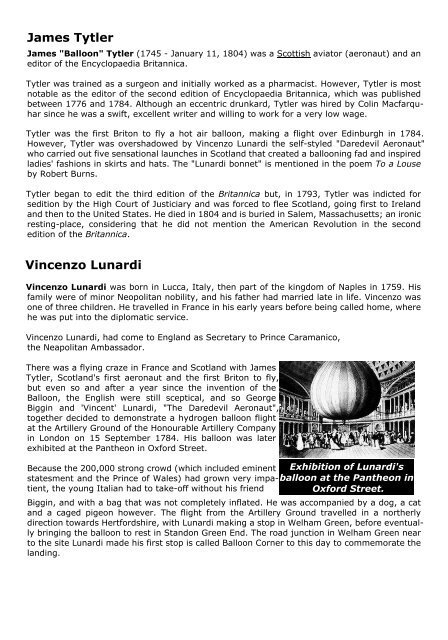You also want an ePaper? Increase the reach of your titles
YUMPU automatically turns print PDFs into web optimized ePapers that Google loves.
James Tytler<br />
James "Balloon" Tytler (1745 - January 11, 1804) was a Scottish aviator (aeronaut) and an<br />
editor of the Encyclopaedia Britannica.<br />
Tytler was trained as a surgeon and initially worked as a pharmacist. However, Tytler is most<br />
notable as the editor of the second edition of Encyclopaedia Britannica, which was published<br />
between 1776 and 1784. Although an eccentric drunkard, Tytler was hired by Colin Macfarquhar<br />
since he was a swift, excellent writer and willing to work for a very low wage.<br />
Tytler was the first Briton to fly a hot air balloon, making a flight over Edinburgh in 1784.<br />
However, Tytler was overshadowed by <strong>Vincenzo</strong> <strong>Lunardi</strong> the self-styled "Daredevil Aeronaut"<br />
who carried out five sensational launches in Scotland that created a ballooning fad and inspired<br />
ladies' fashions in skirts and hats. The "<strong>Lunardi</strong> bonnet" is mentioned in the poem To a Louse<br />
by Robert Burns.<br />
Tytler began to edit the third edition of the Britannica but, in 1793, Tytler was indicted for<br />
sedition by the High Court of Justiciary and was forced to flee Scotland, going first to Ireland<br />
and then to the United States. He died in 1804 and is buried in Salem, Massachusetts; an ironic<br />
resting-place, considering that he did not mention the American Revolution in the second<br />
edition of the Britannica.<br />
<strong>Vincenzo</strong> <strong>Lunardi</strong><br />
<strong>Vincenzo</strong> <strong>Lunardi</strong> was born in Lucca, Italy, then part of the kingdom of Naples in 1759. His<br />
family were of minor Neopolitan nobility, and his father had married late in life. <strong>Vincenzo</strong> was<br />
one of three children. He travelled in France in his early years before being called home, where<br />
he was put into the diplomatic service.<br />
<strong>Vincenzo</strong> <strong>Lunardi</strong>, had come to England as Secretary to Prince Caramanico,<br />
the Neapolitan Ambassador.<br />
There was a flying craze in France and Scotland with James<br />
Tytler, Scotland's first aeronaut and the first Briton to fly,<br />
but even so and after a year since the invention of the<br />
Balloon, the English were still sceptical, and so George<br />
Biggin and 'Vincent' <strong>Lunardi</strong>, "The Daredevil Aeronaut",<br />
together decided to demonstrate a hydrogen balloon flight<br />
at the Artillery Ground of the Honourable Artillery Company<br />
in London on 15 September 1784. His balloon was later<br />
exhibited at the Pantheon in Oxford Street.<br />
Because the 200,000 strong crowd (which included eminent<br />
statesment and the Prince of Wales) had grown very impatient,<br />
the young Italian had to take-off without his friend<br />
Exhibition of <strong>Lunardi</strong>'s<br />
balloon at the Pantheon in<br />
Oxford Street.<br />
Biggin, and with a bag that was not completely inflated. He was accompanied by a dog, a cat<br />
and a caged pigeon however. The flight from the Artillery Ground travelled in a northerly<br />
direction towards Hertfordshire, with <strong>Lunardi</strong> making a stop in Welham Green, before eventually<br />
bringing the balloon to rest in Standon Green End. The road junction in Welham Green near<br />
to the site <strong>Lunardi</strong> made his first stop is called Balloon Corner to this day to commemorate the<br />
landing.


